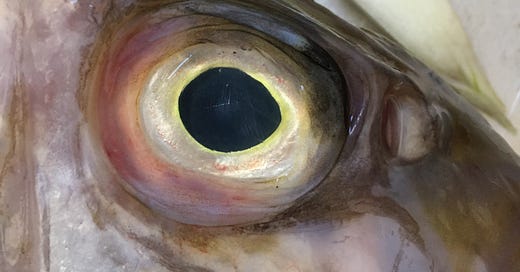Every summer in July, I spend two weeks with my family on the Rhuys Peninsula. It took me a while to fully grasp the nature of this place — a coastline partially marred by the white cinderblock houses so beloved by French retirees. Needing a bit of solitude when the house got too crowded (sometimes there were close to fifteen of us at once!), I spent the years wandering through this land shaped by its remarkably varied landscapes. And somewhere along the way, I learned an important lesson — one that partly inspired this newsletter: sometimes the places most bathed in light hold the richest shadows. The Rhuys Peninsula is a striking example of that.
It’s a 25-kilometer (15,50 miles) stretch of land that seals off the “Little Sea” — the Gulf of Morbihan, as locals call it — from its louder, saltier big sister, the “Great Sea,” or Mor Braz in Breton. Between the two seas is a jumble of pretty beaches, muddy coves, farmland, drab villages, charming town centers, a towering castle, oyster beds, campgrounds, commercial zones, cyclists, oyster farmers, Parisians, and RV crowds. It’s a hodgepodge, sometimes downright messy. But it’s precisely its lack of order, its refusal to follow a single line, that give the place its depth.
On this narrow strip between two seas, you’ll find sandy beaches next to swampy inlets, orchards beside concrete developments, a regal château not far from discount supermarkets, and a mix of oyster farmers, cyclists, campers, and preppy families on vacation. It’s this contrast, the postcard view right up against the tourist trap, that makes the whole area feel so layered, so alive.
Take Route Nationale 780, also known as the Port-Navalo road. It cuts straight through the peninsula, acting as its spine. It divides everything in two: on one side, the open sea; on the other, the gulf. It’s the highway of holidaymakers, the conveyor belt of GPSs, the backbone of utilitarian tourism. And since this is France, it’s dotted with hideous roundabouts. In summer — the yearly national pilgrimage to the coast — it turns into a single-file line of air-conditioned SUVs with bikes strapped to the back, bumper to bumper, horns honking in rhythm.
But here’s the twist: you don’t have to take Route 780. Not at all. If you’re not in a rush, if you’re moving differently — by bike, on foot, off-script — a whole parallel world opens up. Empty paths, old tracks lost in time, silences you didn’t know you needed. And that road I used to hate? I’ve grown to love it. It’s there to draw attention away, to catch the performance-minded, and leave space for wanderers. It’s a screen. A decoy. And in the margins, between two seas, you’ll find a bit of peace: lovely villages untouched by traffic, small producers doing things right, and clever folks making the most of it.
Keep reading with a 7-day free trial
Subscribe to How to get lost in France to keep reading this post and get 7 days of free access to the full post archives.




